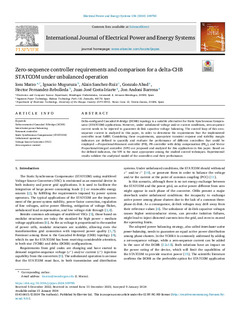Title
Zero-sequence controller requirements and comparison for a delta-CHB STATCOM under unbalanced operationPublication Date
2024Other institutions
Universidad del País Vasco/Euskal Herriko Unibertsitatea (UPV/EHU)Ingeteam (Spain)
Version
Published versionDocument type
Journal ArticleJournal ArticleLanguage
EnglishRights
© 2024 The AuthorsAccess
Open accessPublisher’s version
https://doi.org/10.1016/j.ijepes.2024.109785Published at
International Journal of Electrical Power & Energy Systems Publisher
ElsevierKeywords
Delta-connected Cascaded H-Bridge (DCHB)
Intercluster power balancing
Resonant controller
Static Synchronous Compensator (STATCOM) ... [+]
Intercluster power balancing
Resonant controller
Static Synchronous Compensator (STATCOM) ... [+]
Delta-connected Cascaded H-Bridge (DCHB)
Intercluster power balancing
Resonant controller
Static Synchronous Compensator (STATCOM)
unbalanced operation
Voltage Source Converter (VSC)
Zero-sequence current [-]
Intercluster power balancing
Resonant controller
Static Synchronous Compensator (STATCOM)
unbalanced operation
Voltage Source Converter (VSC)
Zero-sequence current [-]
Field (UNESCO Classification)
Technological SciencesDiscipline (UNESCO Classification)
Electrical engineering and technologyAbstract
Delta-configured Cascaded H-Bridge (DCHB) topology is a suitable alternative for Static Synchronous Compensator (STATCOM) applications. However, under unbalanced voltage and/or current conditions, zer ... [+]
Delta-configured Cascaded H-Bridge (DCHB) topology is a suitable alternative for Static Synchronous Compensator (STATCOM) applications. However, under unbalanced voltage and/or current conditions, zero-sequence current needs to be injected to guarantee dc-link capacitor voltage balancing. The control loop of this zero-sequence current is analyzed in this paper, in order to determine the requirements that the implemented controller must fulfill. Considering these requirements, appropriate transient response and stability margin indicators are defined to quantify and evaluate the performance of different controllers that could be employed —Proportional-Resonant controller (PR), PR controller with delay compensation (PR), and Vector Proportional-Integral controller (VPI) are proposed and analyzed for this application in this paper. Based on the defined indicators, the VPI is the most appropriate among the studied control techniques. Experimental results validate the analytical model of the controllers and their performance. [-]
Collections
- Articles - Engineering [758]
The following license files are associated with this item:






















